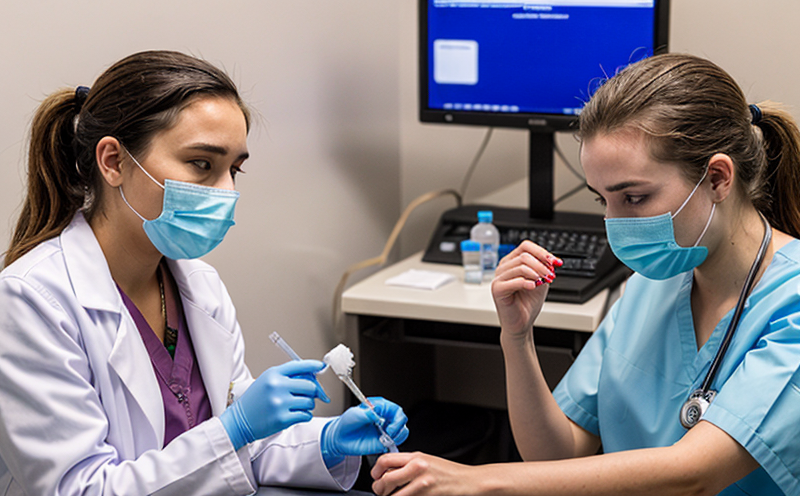ASTM E2881 Molecular Detection of Pathogens in Clinical Labs
The ASTM E2881 standard provides a comprehensive framework for molecular detection methods used in clinical laboratories to identify and quantify pathogens. This method is particularly significant as it ensures the accuracy, precision, and reliability of diagnostic tests that can impact patient care.
ASTM E2881 is designed to address the increasing demand for rapid and accurate identification of pathogens in various clinical specimens such as blood, urine, cerebrospinal fluid, and respiratory samples. The standard covers the entire process from sample collection through nucleic acid extraction, amplification, detection, and reporting.
The use of molecular techniques like Polymerase Chain Reaction (PCR) allows for highly sensitive and specific detection of pathogens even in low concentrations. This is crucial in ensuring early diagnosis and appropriate treatment, which can significantly impact patient outcomes.
One of the key aspects of ASTM E2881 is its emphasis on quality assurance and control measures. Laboratories must follow strict protocols to ensure that their molecular diagnostic tests are accurate and consistent. This includes standard operating procedures (SOPs) for sample handling, nucleic acid extraction, amplification cycles, and data interpretation.
The standard also addresses the challenges associated with false positives and negatives, which can arise due to various factors such as sample degradation, cross-contamination, or instrument malfunction. ASTM E2881 provides guidelines on minimizing these risks through rigorous validation studies and regular calibration of instruments.
In addition to its role in clinical diagnostics, ASTM E2881 plays a vital part in research and development efforts aimed at improving molecular detection methods. By setting clear standards for performance metrics like sensitivity, specificity, and turnaround time, the standard helps researchers evaluate new technologies against established benchmarks.
The implementation of ASTM E2881 not only enhances the quality of diagnostic services but also contributes to public health by facilitating timely interventions in cases where rapid detection is essential. For instance, it can be critical in managing outbreaks of infectious diseases or identifying resistant strains of bacteria.
Furthermore, compliance with this standard demonstrates a commitment to maintaining high standards of laboratory practice and supports the overall goal of improving patient safety and healthcare outcomes. It ensures that clinical laboratories adhere to internationally recognized best practices, thereby gaining credibility within the medical community and regulatory bodies.
Why Choose This Test
- Rapid identification of pathogens in various clinical specimens.
- Highly sensitive and specific detection methods, ensuring accurate diagnosis.
- Compliance with international standards, enhancing the credibility of laboratory results.
- Reduction in false positives and negatives through rigorous quality control measures.
- Supports research and development efforts to improve molecular detection technologies.
- Facilitates timely interventions in cases of infectious diseases or resistant bacteria outbreaks.
Quality and Reliability Assurance
The ASTM E2881 standard emphasizes the importance of quality assurance and reliability in molecular detection methods. Laboratories must establish robust protocols for sample handling, nucleic acid extraction, amplification cycles, and data interpretation to ensure consistent results.
Regular calibration and validation studies are crucial for maintaining instrument accuracy over time. These measures help laboratories identify potential issues early on, allowing them to address these promptly before they affect patient care. Additionally, compliance with ASTM E2881 ensures that diagnostic tests meet stringent performance criteria set by international standards.
By adhering to the guidelines outlined in this standard, clinical laboratories can enhance their reputation as reliable partners in healthcare delivery. This is particularly important given the increasing complexity of modern diagnostics and the growing demand for accurate, rapid results.
Competitive Advantage and Market Impact
The adoption of ASTM E2881 molecular detection methods offers significant competitive advantages in the clinical laboratory sector. Compliance with this standard demonstrates a commitment to maintaining high standards of laboratory practice, which can enhance a lab’s reputation among healthcare providers and patients alike.
By ensuring consistent and reliable results, laboratories that comply with ASTM E2881 can differentiate themselves from competitors who may not meet the same rigorous criteria. This can translate into increased client trust and potentially greater market share. In an era where accurate and timely diagnostic information is essential for effective patient management, such labs are better positioned to attract business.
The use of ASTM E2881 also aligns with broader industry trends toward precision medicine and personalized healthcare. As more emphasis is placed on individualized treatment plans based on genetic and molecular profiles, laboratories that can deliver accurate and reproducible results will be in high demand.
Moreover, the standard’s focus on minimizing errors due to false positives or negatives aligns with global efforts to reduce antimicrobial resistance (AMR). By providing more precise diagnoses, these labs contribute to better antibiotic stewardship practices, which is a critical component of AMR control strategies.





